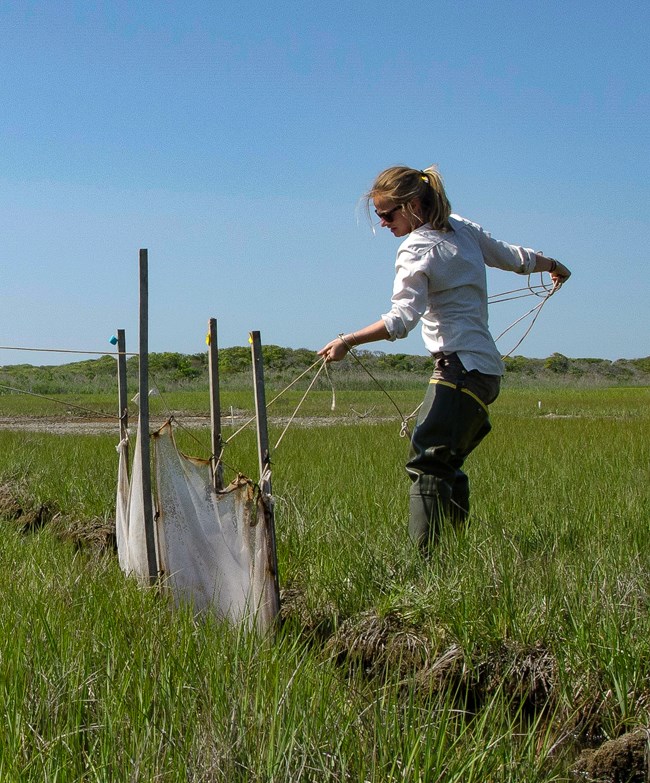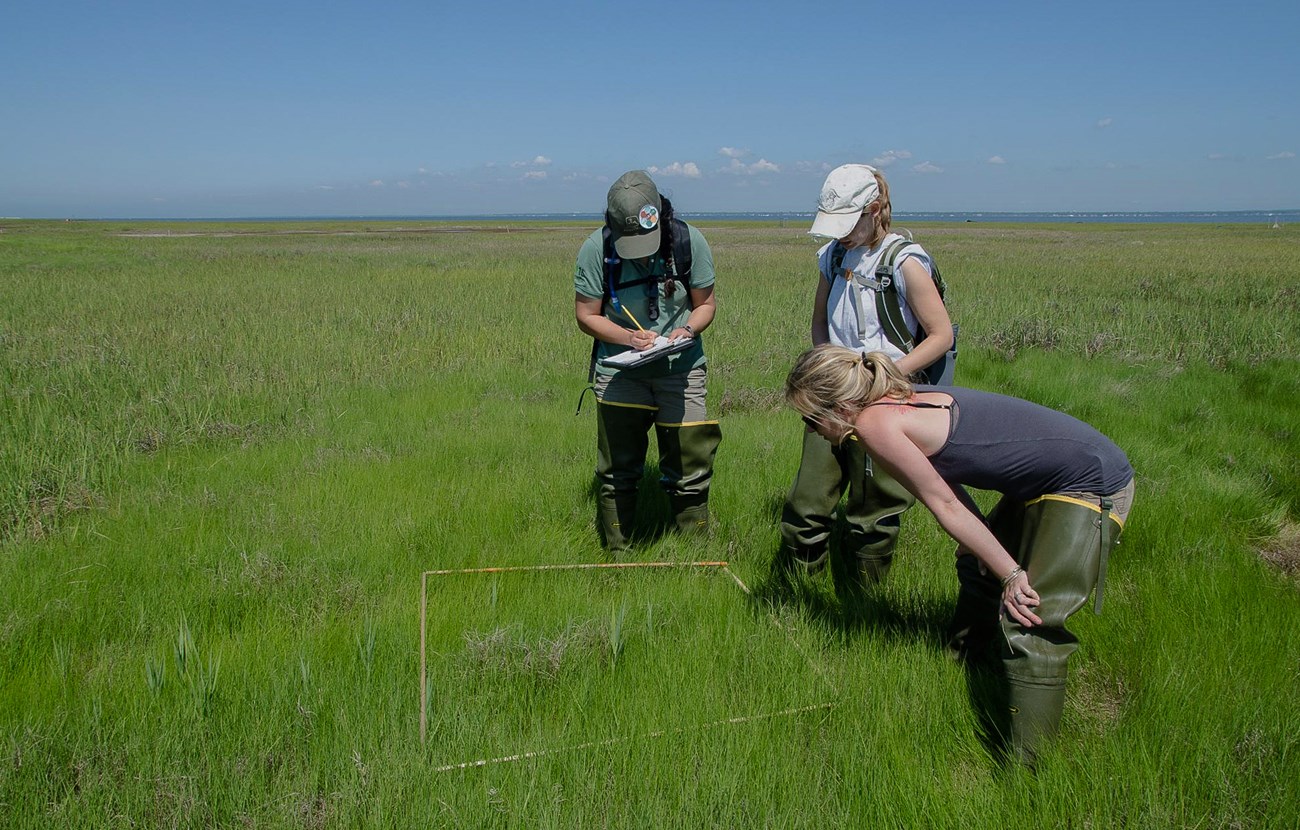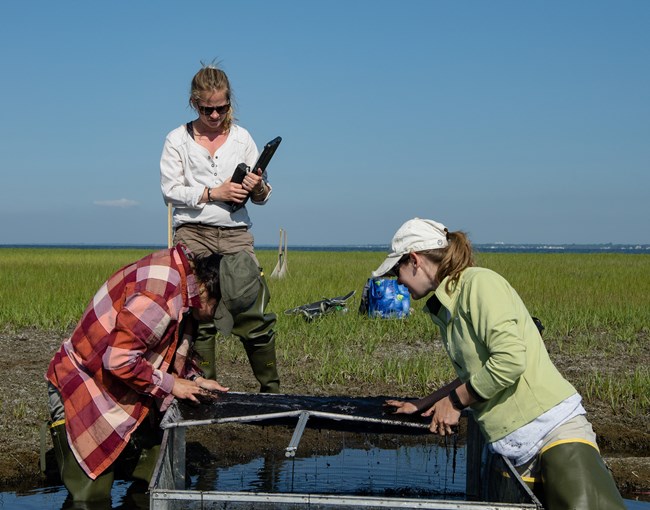Last updated: June 12, 2020
Article
True to Her Roots: One woman’s passion for conservation becomes a reality in her native Rhode Island

Rocks/NPS
Jessica Cressman will endure just about anything to be outdoors. She would rather be soaked to her knees and covered with hundreds of hungry mosquitoes in 100-degree weather than sitting inside at a desk. Fortunately, she finds plenty of chances to get her hands dirty.
After Hurricane Sandy tore up the East Coast in 2012, the National Park Service (NPS) saw the urgent need to monitor the damage and research ways to increase coastal resilience in anticipation of future storms. Storm mitigation and resilience projects funded by NPS created the perfect opportunity for Cressman to work in her element while making a lasting contribution to coastal communities.
She began researching salt marshes while working towards a graduate degree in environmental science and management at the University of Rhode Island (URI). During the summer months, she joined a team of NPS researchers at Fire Island National Seashore, a barrier island off the coast of Long Island, New York. They collected data for the Notheast Coastal and Barrier Network (NCBN) to track how salt marshes keep up with rising sea levels, and to determine which species of vegetation are most affected. These salt marsh vegetation surveys are key to wildlife conservation, which happens to be Cressman’s specialty.
“For me, conservation is very important. All the projects are conservation-based,” she explained. “Anytime I can get out and tell someone about what I do, and why this is important, that motivates me.”

Rocks/NPS
Cressman’s determination and love of the outdoors get her through tough days in the field.
“The ticks and mosquitoes are pretty bad, but I could be working in an office all day,” she reflected optimistically. To reach her field site, she had to take a boat packed to the brim with bug spray, GPS equipment, data sheets, plant ID books, rain gear, food, and drinking water. “You pretty much carry your whole life out there.”
In the field, Cressman waded through stagnant salt water with mosquitoes and flies following her every move. She wore heavy pants and hip-high boots in mid-summer heat, along with a suffocating bug net to shield her face.
“You’re claustrophobic and sweating, and you have this big net in your face all day,” she reminisced with a hint of amusement.

Rocks/NPS
From dawn to dusk, Cressman plotted square grids on the marshlands and estimated the percentage of each type of vegetation within the plotted area. During summer 2016, she worked on 13 different marshes and meticulously plotted as many as 300 vegetation points on each.
“You’re out there for eight, nine, ten hours—pretty much the whole day,” Cressman explained. Although it was exhausting, she loved the work because it allowed her to enjoy nature. “I always like doing fieldwork. I like being outside. The marsh is a very peaceful environment.”
In fact, that very environment sparked a new direction in Cressman’s work. Always surrounded by salt marshes, she developed a great appreciation for the birds that inhabit them. One of these species, the saltmarsh sparrow, is as fragile as the habitat she’s working to conserve. These delicate animals only nest in salt marshes. Once hatched, the chicks have to be able to fly before the high tide that arrives with the full moon.
“I never thought I’d be a crazy bird person,” she said. However, “anytime you get to handle them, you have a new appreciation for them.” Now, her dream job is to work on bird conservation, particularly habitat management of the areas they use for nesting or migration.

NPS
When not trudging through marshes, Cressman puts her fieldwork data to use at URI’s Environmental Data Center (EDC). The EDC lab, founded by Dr. Peter August, a professor of Natural Resources Science at URI, employs the latest technology and spatial data processing to analyze and publicize environmental data. Cressman now works full-time as a research associate for the EDC and uses the mapping software ArcGIS to conduct spatial analyses, outline habitat areas, and track sea level rise. Her fieldwork data is used to track the effects of sea level rise on salt marshes, and to model hurricane inundation to predict damage caused by future storms. If a category three hurricane hits the East Coast, Cressman and the EDC team can accurately predict which areas will be flooded and which will be saved. Although this is crucial to understanding coastal resilience in national parks, it isn’t always easy to explain.
“It’s tough to describe to people what you do,” she noted. “For now I tell them I make maps, and they seem okay with that.”
Cressman’s passion for conserving coastal environments comes from her love of the outdoors as well as her Rhode Island upbringing. She has always found a way to contribute to her native state, and now her contribution to the EDC lab is helping to protect the coasts of Rhode Island, and beyond.
“I’m tied to Rhode Island,” she pronounced with a smile. Her love of nature and native soil keep her true to her roots.
Written by Ainsley Ryan, Mary Mallinger, Paul McDivitt, Jamie Remillard, and Caroline Gottschalk Druschke (SEAcomm URI)
Visit the Northeast Coastal and Barrier Network website to learn more about monitoring salt marsh vegetation and salt marsh nekton!
